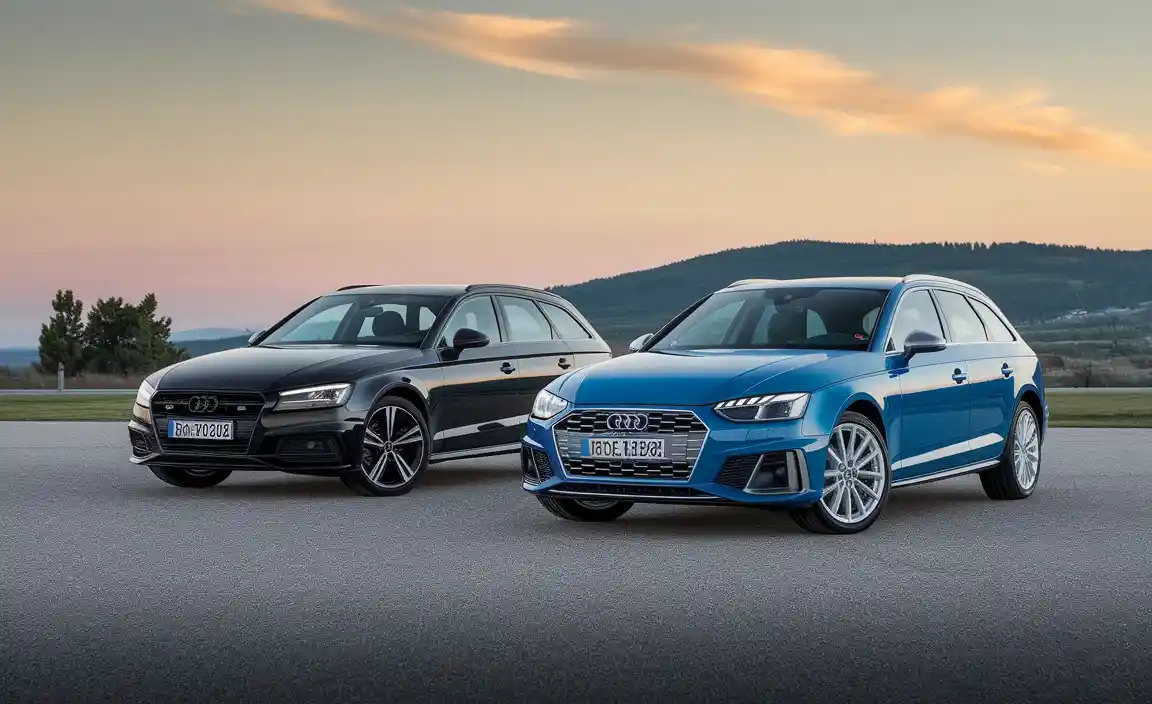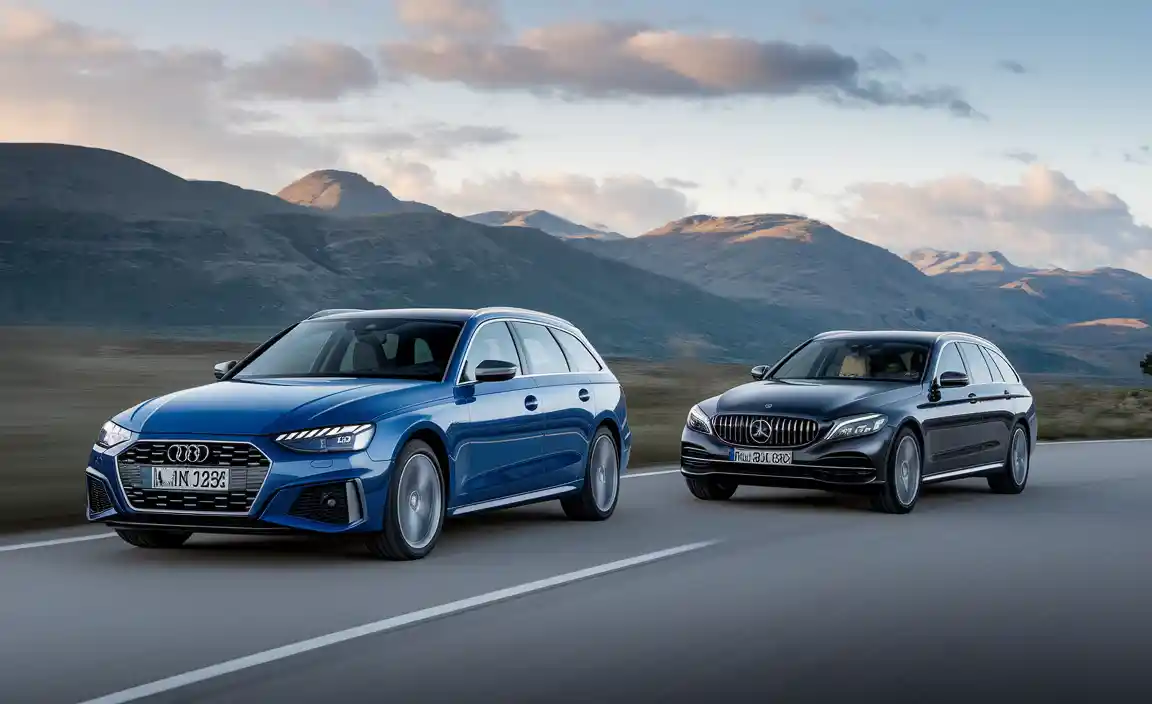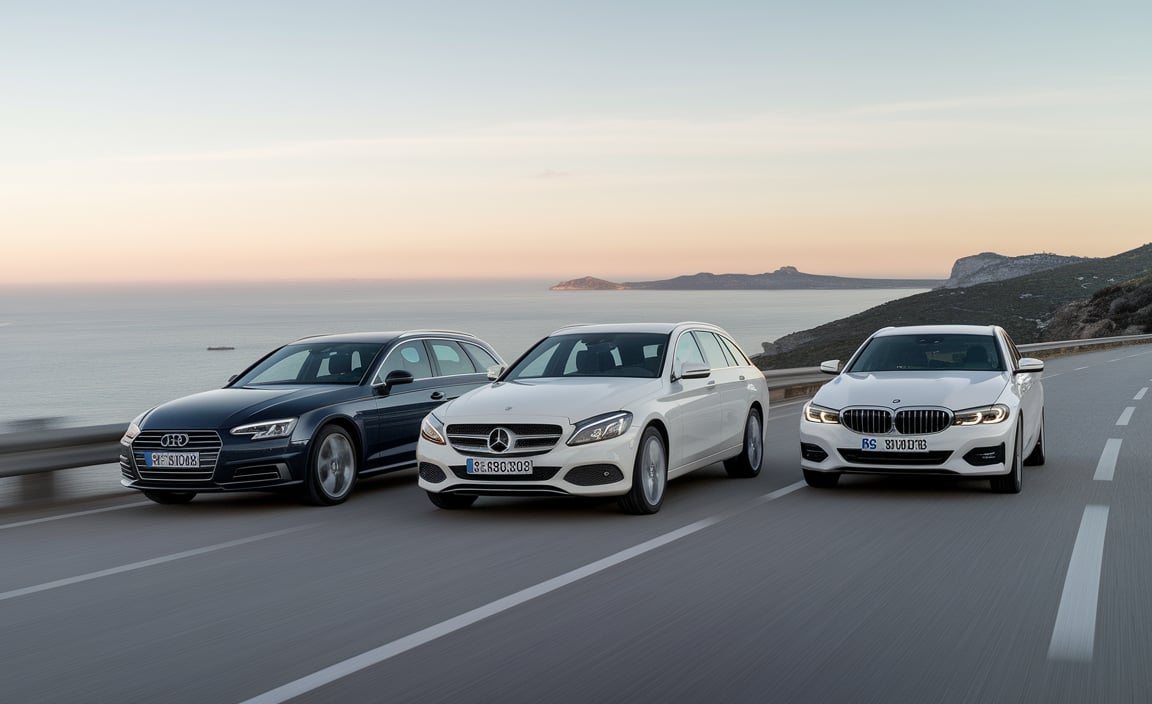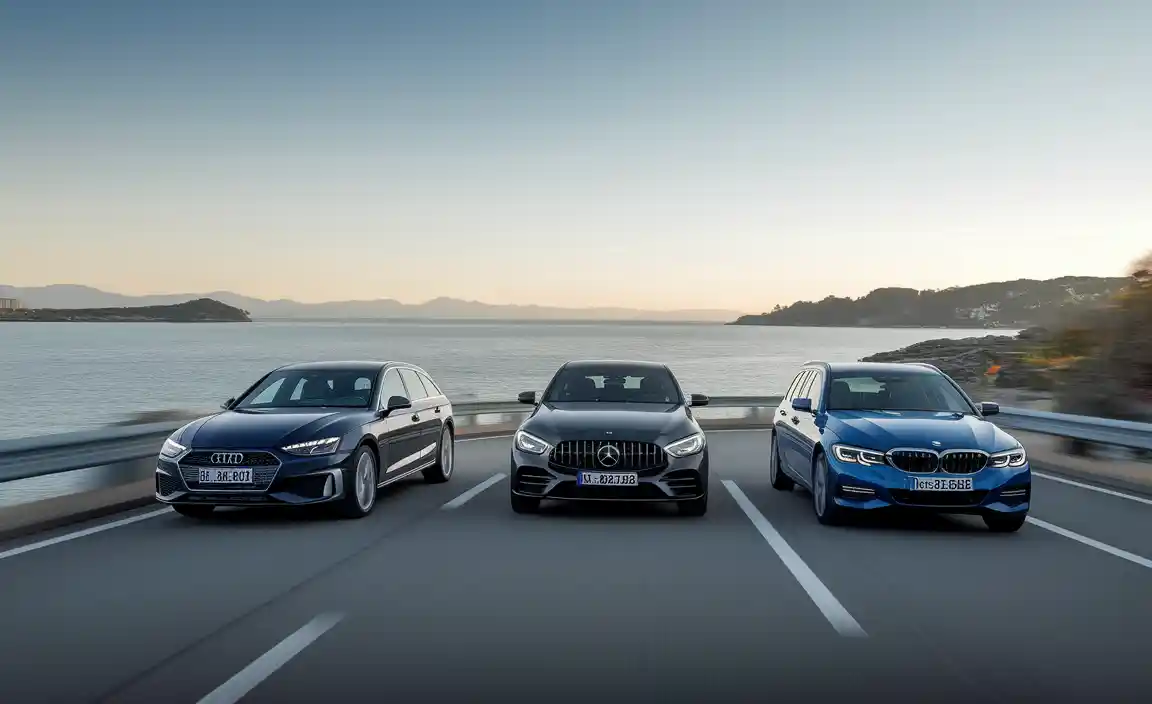Imagine cruising down a scenic route with your favorite playlist. You’ve got room for family gear, office supplies, or even your dog’s favorite blanket. That’s the kind of versatility we’re talking about in the world of modern estate cars—and three big German names stand out: the Audi A4 Avant, the Mercedes C‑Class T‑Modell, and the BMW 3‑Series Touring.
In this friendly showdown, we’ll look at each model in turn—how they perform, feel, look, and cost. Let’s have a comparison of Audi A4 Avant vs C-Class & 3-Series Touring. We’ll help you see which one suits your life better. Ready? Let’s hit the road.

Overview Of Competing Models
Audi A4 Avant
The Audi A4 Avant aims for balanced everyday appeal. Think sleek design, high-tech cabin, and steady performance. It’s not loud; it’s refined. Even so, it packs enough spirit to keep you engaged.
Mercedes C‑Class T‑Modell
The C‑Class T‑Modell lives somewhere between luxury and practicality. Imagine sipping coffee on a long haul, wrapped in premium materials yet with a flexible boot ready for that weekend sports gear.
Bmw 3‑Series Touring
The 3‑Series Touring leans sporty. It’s the one that makes you say, “Let’s take the scenic route.” BMW’s classic handling and rear‑wheel chill vibes make it stand out when driving really matters.
Engine Performance Comparison

Power And Acceleration
When you’re pulling out of a roundabout or merging onto the motorway, engine response matters more than you think. Here’s how these three handle it:
- Audi A4 Avant: Offers a range of 2.0-liter TFSI petrol and TDI diesel engines. The 40 TDI variant, for example, delivers 204 hp and 400 Nm of torque. It hits 0–100 km/h in about 7.1 seconds. Solid, predictable power that feels effortless.
- Mercedes C-Class T-Modell: The C 220 d shines here, with 200 hp and a healthy 440 Nm of torque. It’s paired with a silky 9G-TRONIC automatic gearbox that’s tuned more for smoothness than sport. Still, it does 0–100 km/h in 7.4 seconds, and that diesel torque really shows during overtakes.
- BMW 3-Series Touring: The 320d Touring xDrive is all about balance—190 hp, 400 Nm, and 0–100 km/h in around 7.5 seconds. BMW’s 8-speed Steptronic transmission is a gem. It shifts so intuitively that you almost forget it’s automatic.
So if you’re chasing numbers, Audi gets there slightly quicker. But if you’re after effortless surge and refined delivery, Mercedes might feel more luxurious. The BMW is all about involvement—it doesn’t just get you up to speed, it encourages you to enjoy the journey.
Fuel Efficiency And Emissions
Let’s talk about real-life costs. You want performance, sure—but you also want a car that doesn’t gulp fuel like it’s happy hour.
- Audi A4 Avant 40 TDI: Expect around 5.0–5.5 L/100 km depending on your driving mix. Emissions stay low for its class, often around 130–140 g/km CO₂.
- Mercedes C 220 d T-Modell: The most efficient of the trio in many tests. You can achieve 4.8–5.1 L/100 km without trying too hard. CO₂ sits below 135 g/km, making it great for company car taxes and long-distance savings.
- BMW 320d Touring xDrive: Comes in just above 5.2 L/100 km on average, with xDrive adding a bit more weight and fuel use. CO₂ emissions are slightly higher, depending on wheels and tyres fitted.
Each car is relatively eco-conscious for a diesel estate. But Mercedes takes the edge here, especially if you’re clocking thousands of kilometres a month.
Driving Dynamics

Handling And Ride Comfort
Let’s be honest—no one buys an estate car for drift battles (we hope). But they should still be enjoyable on the road.
- BMW 3-Series Touring: This one’s for the purists. Rear-wheel-drive architecture (or rear-biased xDrive in AWD models), near-perfect balance, and a steering feel that’s almost telepathic. The car communicates every corner.
- Audi A4 Avant: With quattro versions, the grip is unshakable. It’s stable and composed, though slightly numb at the wheel. Perfect for relaxed cruising and long trips, but it won’t excite die-hard enthusiasts.
- Mercedes C-Class T-Modell: The softest of the three, and that’s not a bad thing. The ride is cushioned and elegant. On twisty B-roads, you might feel a little more body roll—but on the motorway, it’s pure chill.
Bottom line? BMW for fun, Audi for balance, and Mercedes for comfort.
Sportiness Vs. Smoothness
This comes down to personality. BMW has always been the sportiest sibling, Audi plays it cool and confident, and Mercedes pampers you like a five-star hotel on wheels.
If you’re someone who values sporty DNA and sharp cornering, BMW all the way. But if your vibe is smooth operator, quiet cabin, minimal drama, Mercedes-Benz wins your heart. Audi stays neutral—refined but not flamboyant.
Technological Advancements
Infotainment Features
All three manufacturers are on the bleeding edge of in-car tech. Let’s break it down:
- Audi: Features its “Virtual Cockpit” as standard in higher trims—a fully digital gauge cluster that’s crisp, configurable, and very cool. Pair it with the 10.1-inch MMI touchscreen, and it’s one of the most intuitive systems around.
- BMW: The latest iDrive 8 brings a huge curved display that merges driver info and infotainment. It’s super responsive, voice-controlled, and even supports gestures like waving your hand to adjust volume. Some love it; others prefer knobs.
- Mercedes: MBUX feels like something from the future. It listens when you say “Hey Mercedes” and handles everything from navigation to cabin lighting. The screens are stunning, and even base models feel premium.
Winner? Depends on your style. Audi keeps it clean. BMW is highly functional. Mercedes? All-out luxury tech.
Driver Assistance And Safety Systems
All three rivals earn top marks from Euro NCAP, so you’re safe in any. But let’s look at the gadgets:
- Audi: Offers a strong suite of driver aids—adaptive cruise control, lane-keeping, and predictive efficiency assistant. But some features are optional unless you go for S line or higher.
- BMW: Its Driving Assistant Professional suite includes adaptive cruise, lane-centering, and parking assist. Works beautifully, but again, bundled as paid extras.
- Mercedes: Often the most generous with standard safety kit. Even entry trims include blind spot assist, active brake assist, and a great lane-keep function.
Interior Space And Comfort

Passenger Comfort
When you step into any of these three estates, you instantly notice how far we’ve come from the spartan interiors of old wagons. Today, comfort is just as much a priority as cargo space, and each model nails it uniquely.
- Audi A4 Avant: Audi interiors are known for being modern and minimal. The A4 Avant keeps things clean and symmetrical, with soft-touch materials and excellent ergonomics. The seats are supportive—perfect for long drives—but can feel a bit firm if you’re used to cushier cars. Space-wise, it offers ample leg and headroom for both front and rear passengers. It’s more than enough for a small family or tall friends.
- Mercedes C-Class T-Modell: This is where Mercedes-Benz excels. Slide into the driver’s seat and it’s like being in a boutique lounge. There’s a calmness in the layout, especially with ambient lighting glowing softly at night. The front seats feel plush and inviting, while the rear offers just enough room for adult passengers—though it can feel a little tighter than the Audi if you’re over 6 feet tall.
- BMW 3-Series Touring: BMW takes a more driver-focused approach inside. The cockpit wraps around you slightly, making it feel sporty and intentional. Materials are premium, although slightly more restrained than the Mercedes. Space is similar to Audi in the front, but rear legroom is a touch tighter—especially with the optional sunroof cutting into headspace.
Verdict: For outright comfort and luxury? Mercedes takes it. For a clean, modern feel? Audi wins. And if you love feeling like the car is built around you, BMW makes you feel in control.
Cargo And Storage Solutions
Let’s talk practicality—the main reason anyone even considers a wagon.
- Audi A4 Avant: Offers 495 liters of boot space with the seats up, expanding to 1,495 liters when folded flat. The boot floor is low and wide, making it super easy to load up. Audi also adds thoughtful touches like bag hooks, adjustable nets, and a hands-free electric tailgate.
- Mercedes C-Class T-Modell: Slightly less boot space at 490 liters, but it’s clever in how it uses it. The loading lip is smooth and flat, and Mercedes includes adjustable dividers and underfloor compartments for hiding valuables. Fold down the rear seats, and you get a generous 1,510 liters.
- BMW 3-Series Touring: Comes out on top here with 500 liters of standard cargo space, expanding to 1,510 liters as well. The standout feature? A split-opening tailgate. You can pop just the glass section open to drop in smaller items—super handy in tight parking spots or if you’re just dropping groceries in.
Whether you’re packing for a holiday, moving boxes, or just heading to IKEA, any of these estates will carry what you need. But BMW edges ahead slightly on cleverness and usable volume.
Design And Aesthetics

Exterior Styling Differences
Aesthetics are subjective, of course. But here’s how each wagon presents itself on the road:
- Audi A4 Avant: Understated elegance. Audi’s design language is clean, crisp, and modern. The signature single-frame grille, sleek LED lights, and sharply sculpted sides give it a premium look without being flashy. It’s the car you nod at approvingly, even if you’re not a car nerd.
- Mercedes C-Class T-Modell: Curvier and more expressive. The new generation borrows design cues from the larger E-Class and S-Class. The front end feels more fluid, with swept-back lights and a softer silhouette. It looks expensive—and in most cases, it is.
- BMW 3-Series Touring: The sportiest of the trio. The large kidney grilles are bold (some say too bold), but they give it presence. The side profile is muscular, with a rear that looks like it’s ready to pounce. It’s the most assertive visually—great if you like to stand out a bit more.
If you prefer classy minimalism, go Audi. If you want elegance and flair, pick Mercedes. And if bold, sporty lines excite you, BMW is the clear winner.
Interior Design Highlights
Inside, each car mirrors its exterior philosophy:
- Audi: Linear dashboard, cool aluminum accents, and minimalist screens. Nothing feels overdone. Even the air vents look like they were styled by someone from a high-end furniture store.
- Mercedes: The most glamorous interior here. Glossy piano black surfaces, flowing ambient light strips, turbine-style vents—it’s all about sensory delight. The vertical screen is a bold centerpiece.
- BMW: Function meets sport. The new curved display is stunning, and the layout still keeps important controls physical. Everything feels angled toward the driver, giving a real sense of control and intention.
Cost Of Ownership

Purchase Price Comparison
When it comes to premium wagons like the Audi A4 Avant, Mercedes C-Class T-Modell, and BMW 3-Series Touring, pricing is a tricky game. It’s not just about what you pay upfront—it’s about what you get for that money.
Here’s a general ballpark for entry-level diesel versions with similar specs:
- Audi A4 Avant 40 TDI: Starts around €47,000
- Mercedes C 220 d T-Modell: Starts around €50,000
- BMW 320d Touring: Starts around €48,500
As you climb up the trim ladder—with added tech, better wheels, sunroofs, or special packages—expect to hit €55,000–€60,000 quite easily.
Mercedes typically has the highest entry price, partly because it includes more standard equipment, especially in base trims. BMW offers slightly more flexibility with packages. Audi falls right in the middle, often giving you a good mix of value and style.
Maintenance And Running Costs
Owning a premium estate doesn’t mean you have to dread garage visits—but it’s important to go in with open eyes. Routine Maintenance (per year or every 15,000 km, average cost):
- Audi A4 Avant: €450–€600
- Mercedes C-Class T-Modell: €500–€650
- BMW 3-Series Touring: €450–€600
While BMW and Audi offer prepaid service plans that help flatten those costs, Mercedes-Benz servicing tends to be a touch more expensive due to more premium parts and branded labor rates.
Insurance premiums will also depend on your age, location, and driving history, but BMW often carries slightly higher premiums due to its more performance-oriented branding.
Fuel consumption matters too, especially for high-mileage drivers. As we discussed earlier:
- Mercedes C 220 d is the most efficient on paper and often in practice.
- Audi comes close, especially in real-world driving.
- BMW’s xDrive system adds weight and can slightly increase fuel use.
If you’re budget-conscious in the long run, the Audi and BMW offer great value—but the Mercedes wins if comfort and included features are a priority worth paying for.
Pros And Cons Of Each Model

Advantages Of Audi A4 Avant
- Balanced personality: Not too sporty, not too soft.
- Virtual Cockpit and infotainment are among the best in class.
- Elegant design that stays modern without being loud.
- Feels compact in the city but roomy on the inside.
Advantages Of Mercedes C-Class T-Modell
- Supreme ride comfort—ideal for long trips and family hauls.
- Most luxurious interior feel, especially in higher trims.
- Excellent fuel efficiency from the 220 d engine.
- Strong resale value and premium brand image.
Advantages Of BMW 3-Series Touring
- Best driving experience—engaging, agile, fun.
- Rear-wheel-drive layout (or xDrive) offers great control.
- Wide engine options including plug-in hybrids and sporty variants.
- Smart tailgate and practical layout for daily use.
Drawbacks Of Audi A4 Avant
- Less emotional or exciting to drive than BMW.
- Some key driver aids cost extra.
- Firm ride in sportier trims.
Drawbacks Of Mercedes C-Class T-Modell
- Higher starting price.
- Not the best handling in corners—less sharp than rivals.
- Rear space can feel tight with panoramic roof option.
Drawbacks Of BMW 3-Series Touring
- Slightly firmer ride—might not suit comfort-first drivers.
- Some options are locked behind pricey trim packs.
- Styling may be polarizing (especially the big grille).
Conclusion
The Audi A4 Avant, Mercedes C-Class T-Modell, and BMW 3-Series Touring each bring something unique to the table. Audi blends tech and elegance, Mercedes offers supreme comfort, and BMW delivers the most fun behind the wheel.
All are efficient, practical, and premium—so the right choice depends on your priorities: sleek design, luxury ride, or sporty drive. Still unsure? Take a test drive and let the steering wheel decide.
FAQs
1.Which Is The Most Fuel-Efficient Wagon Among The Three?
The Mercedes C 220 d T-Modell often edges ahead with real-world consumption of around 4.8 L/100 km.
2.Which Estate Car Has The Most Boot Space?
The BMW 3-Series Touring and Mercedes T-Modell both offer up to 1,510 liters of space with seats folded.
3.Is The Audi A4 Avant Reliable For Long-Term Use?
Yes, especially the diesel versions. Audi’s 2.0 TDI engine is proven and built for distance.
4.Which One Drives The Sportiest?
Without question, the BMW 3-Series Touring. It has the sharpest handling and a more involved driving feel.
5.What Is The Best Choice For Family Comfort?
The Mercedes C-Class T-Modell wins with its soft ride and plush, quiet cabin.
6.Which Model Has The Most Advanced Infotainment System?
It’s close, but Mercedes’ MBUX system feels more premium and intuitive for most users.
7.Are Maintenance Costs High For These Cars?
Premium brands do cost more to maintain, but prepaid plans and diesel efficiency help keep things manageable.
8.Which Car Looks The Most Stylish?
Totally subjective—but many find Audi’s clean lines timeless and elegant, while BMW brings sporty flair.
9.Can I Get These Wagons With AWD?
Yes! BMW x Drive, Audi quattro, and Mercedes 4MATIC are all available, depending on engine/trims.
10.Which One Offers The Best Resale Value?
Historically, BMW and Mercedes models hold value slightly better than Audi in most European markets.